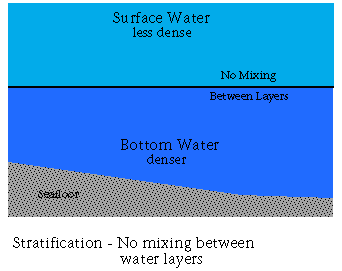 | ||||
 |
Estuarine ScienceDensityThe density of water depends on the temperature of the water and the amount of salt dissolved in the water. More salt makes the water denser and colder water is denser than warm water. Cold salty water is the densest and warm fresh water is the least dense. All bodies of water have the least dense water on top and the densest water on the bottom. Water will always arrange itself so that there is an increasing density toward the bottom. In an estuary, the fresh water flowing in is found at the surface because it has no dissolved salts and is much less dense than the salty water in the ocean. The fresh water will mix with the ocean water and there will be less difference in density.  Sometimes there is a big difference in density between the surface layer and the bottom layer. The big difference in density will prevent mixing between the surface and bottom layers. This condition is called stratification. Stratification often occurs in Narragansett Bay during the summer months. The surface water warms and becomes much less dense than the bottom water. If there is not wind driven mixing, the stratification can persist for some time. The Providence River is often stratified because the surface water is fresh water from the rivers and the bottom water is salty, Bay water. Stratification can be a problem for the health of the Bay because when the surface and bottom layers don't mix, there is no source of dissolved oxygen for the bottom layer. The dissolved oxygen can be used up and hypoxic or anoxic conditions can occur, leading to the death of creatures living in the bottom water.
|
|||